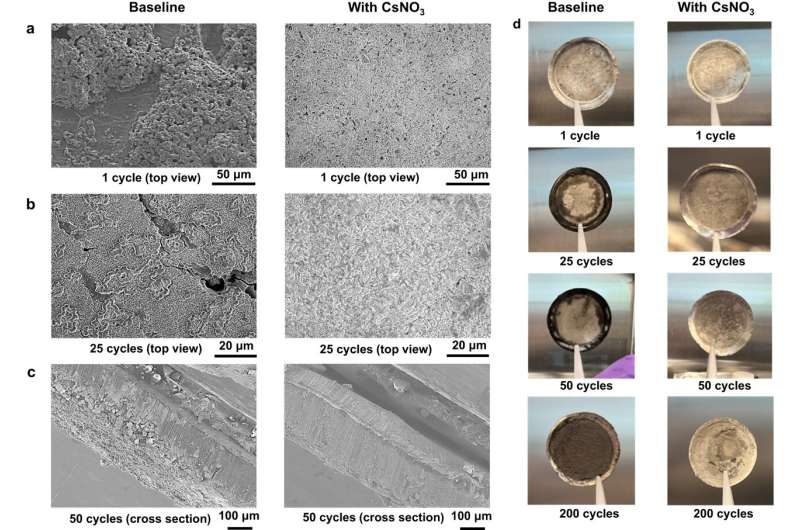
On a mission to build better electric vehicle batteries, chemists at the U.S. Department of Energy's (DOE) Brookhaven National Laboratory have used an electrolyte additive to improve the functionality of energy-dense lithium metal batteries. By adding a compound called cesium nitrate to the electrolyte that separates the battery's anode and cathode, the research team has significantly improved the charging rate of lithium metal batteries while maintaining a long cycle life.
The team's new work, recently published in Nature Communications, targets the interphase—a protective layer formed on the battery's anode and cathode. This layer, which prevents degradation of battery electrodes, is the key to creating lithium metal batteries that can be charged and discharged as many times as lithium-ion batteries.
"We wanted to improve the charging rate of the current state-of-the-art lithium metal batteries," explained Muhammad Mominur Rahman, a research associate in the Electrochemical Energy Storage Group of the Chemistry Division at Brookhaven and first author on the new paper. "But we also wanted to stabilize the batteries with a more protective interphase so they would last longer."
In addition to successfully stabilizing the battery, Rahman's electrolyte additive altered the battery chemistry in an unexpected way.
"Mominur's findings challenge conventional beliefs about the components of an effective interphase," said Enyuan Hu, Brookhaven chemist and principal investigator within the Electrochemical Energy Storage Group. "We're excited to see how these findings contribute to the major DOE effort focused on lithium metal batteries."
One step toward a larger goal
Hu and his team are working among other battery experts as part of the Battery500 Consortium, a collaboration of several national labs and universities. The Consortium, which is led by DOE's Pacific Northwest National Laboratory, is striving to make batteries with an energy density of 500 watt-hours per kilogram—more than double the energy density of today's state-of-the-art batteries.
This energy density cannot be achieved in the lithium-ion batteries powering most of today's battery-operated devices—including phones, television remotes, and even electric vehicles. So, scientists needed to turn to lithium metal batteries to pursue their goals. These batteries possess a lithium metal anode, rather than the graphite anode present in lithium-ion batteries.
"The lithium metal battery is attractive because it can give twice the energy density of a battery with a graphite anode," explained Rahman. "But there are lots of challenges to tackle."
Brookhaven's most recent research addresses one of these challenges—striking a balance between the charging speed and the cycle life.
The electrolyte that typically enables fast battery charging is also likely to be reactive with the lithium metal anode. If these chemical reactions proceed uncontrollably, the electrolyte decomposes and reduces the battery's cycle life. To prevent this from happening, Brookhaven chemists set out to engineer the interphase.
Previous studies had indicated that the lithium metal anode could be stabilized with a cesium additive. But to increase the charging rate while maintaining the battery cycle life, the anode and cathode need to be stabilized simultaneously. The Brookhaven scientists believed cesium nitrate could serve this purpose for lithium metal batteries. As they had hypothesized, the positive cesium ion accumulated on the negatively charged lithium metal anode side of the battery, while the negative nitrate ion accumulated on the positively charged cathode.
To better understand how the cesium nitrate additive influenced the electrolyte composition and battery performance, the chemists brought the new batteries to the National Synchrotron Light Source II (NSLS-II), a DOE Office of Science user facility at Brookhaven Lab.